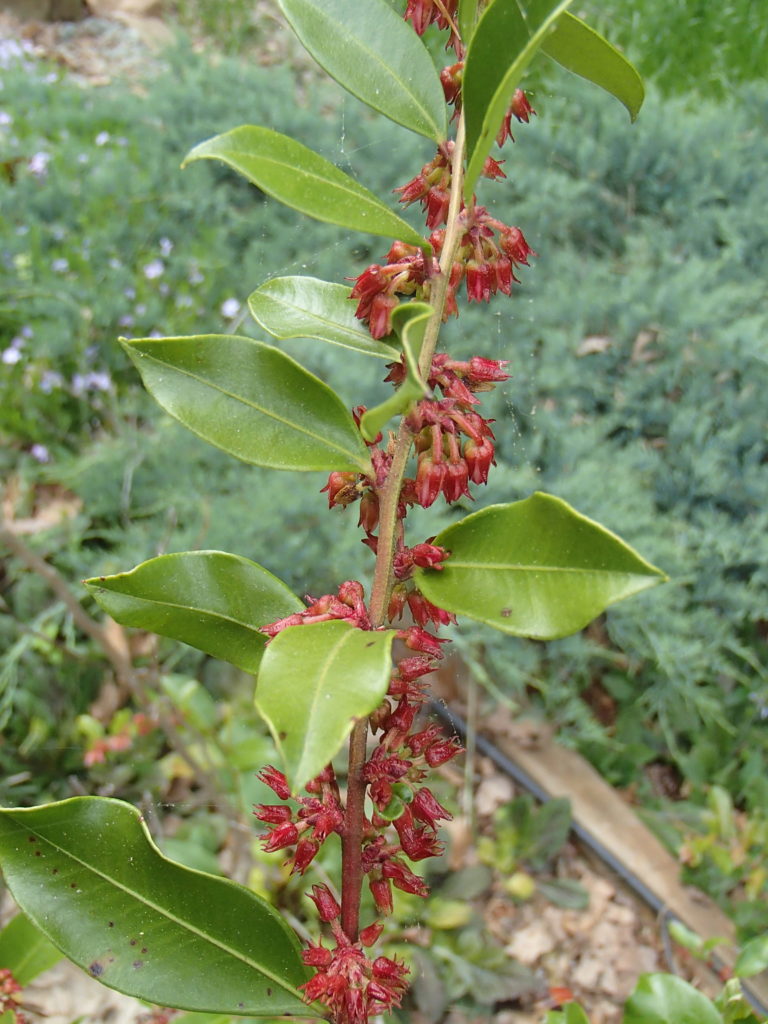Shining Fetterbush (“lucida”) is a commonly encountered evergreen shrub of the south, 3-5 feet tall and wide (or occasionally taller), found mostly in counties of the Atlantic and Gulf Coastal Plains from Virginia south to Florida and west to Louisiana. The leaves are alternate, smooth, thick, and leathery. The sweetly fragrant spring flowers are urn-shaped, pink/white, hanging in clusters from the axils of the leaves all along the stems. Although in nature it is found in some dry habitats, it is much more often encountered in wet ones such as pocosins and bogs. Shining Fetterbush tolerates full sun with sufficient moisture, but thrives in partial sun to full shade with medium moisture requirements and moist, well drained soil. It reproduces by suckering, lending itself to forming an attractive evergreen hedge, and performing well in mixed shrub plantings. Mellichamp (Native Plants of the Southeast): “. . .one of the best evergreen shrubs we have tried (at UNC Botanical Gardens) . . . relatively unknown in cultivation and needs wider testing.”
NURSERY HOURS
Wednesday: 10-4 Thursday: 10-6 Friday-Saturday: 10-4 Sunday: 12-4
Lyonia lucida

Key Info
Scientific Name: Lyonia lucida (Lam.) K. Koch
Common Names: Fetterbush Lyonia, Shinyleaf, Fetterbush, Staggerbush, Hurrahbush, Shining Fetterbush, Shinyleaf, Fetterbush
Family Names: Ericaceae (Heath Family)
Plant Type: Tree / Shrub
Leaf Retention: Evergreen
Flower Color: pink/white
Additional Info
Habit: Shining Fetterbush is a multi-stemmed, suckering shrub with an open, arching habit of medium texture. Branches are loose and sharply three-angled.
Height: 3' to 5'
Spread: 3'-5'
Soil Conditions: average to moist well drained, acidic pH (See Cultural Notes.)
Leaves: Leaves are alternate, simple, entire, eliptical to lanceolate, thick, shiny, a coppery color when young maturing to a dark green above and dull green beneath, 1-3 in. long. Each leaf has a major vein just inside the leaf edge, and a distinct ridge occurs around the lower side of the leaf margin.
Flowers (or reproductive structures: The inflorescence is a bundle of 10-15 drooping, small ( 1/4 inch long), fragrant, urn-shapedl flowers, white or shell pink or reddish, at the axils of the leaves on the previous seasons growth, in late winter or early spring.
Fruit: Fruits are approximately 1/3-inch-long 5-parted woody capsules that dry to brown and split open to release the seeds at maturity.
Natural Distribution: Shining Fetterbush grows in dry habitats (e.g., Saw Palmetto prairie habitat) but it is usually found in wet places, including habitat that is periodically flooded, such as swamps, pocosins, bogs, bays, wet savannas. Even so, it prefers well drained soil to saturated soil.
USDA Hardiness Zone: 7 to 9
USDA Wetland Indicator Status in NC: FACW
Pollination: Bees, butterflies, other insects.
Wildlife Connections: Attracts butterflies and native bees.
Propagation: By seeds, root cuttings, or division.
